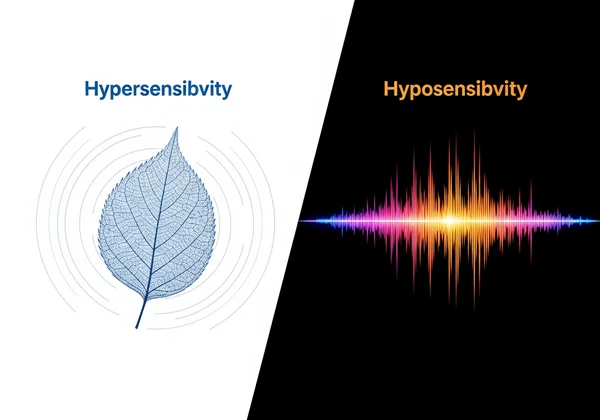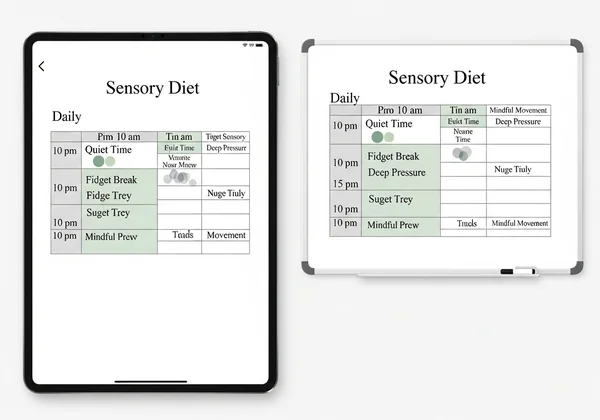Managing Sensory Overload: 10 Strategies After Your RAADSR Test
Navigating a world that often feels too loud, too bright, or too intense is a common experience for many autistic individuals. If you've recently explored your traits through a tool like an online RAADSR test, you might be gaining a new understanding of your unique sensory profile. This new insight often sparks the crucial question: "What can I do now?" This guide explores 10 practical strategies to help you identify your triggers and effectively manage sensory overload in your daily life, turning overwhelming moments into manageable ones. The first step to understanding these sensitivities is self-reflection, which you can begin with a free autism screening.

Understanding Autistic Sensory Issues: Why You Feel What You Feel
Understanding the "why" behind your sensory experiences is vital before building your toolkit. For many autistic people, the brain processes sensory information—sights, sounds, smells, tastes, and textures—differently. This isn't a flaw; it's a fundamental aspect of neurodiversity. It means everyday stimuli others filter out can feel amplified and overwhelming, leading to stress, anxiety, or withdrawal. Recognizing this is not about finding something "wrong" but about acknowledging how your brain is wired.
Identifying Your Unique Sensory Triggers and Patterns
Your sensory profile is as unique as your fingerprint. The first step toward management is becoming a detective of your own experiences. Start a simple log or journal. When do you feel most overwhelmed or exhausted? Note the environment: the lighting, the background noise, the clothes you're wearing, or the smells in the air. Over time, you’ll begin to see patterns. Perhaps you thrive in quiet, dimly lit spaces but find fluorescent-lit supermarkets draining. This self-awareness is the foundation of an effective sensory toolkit and a key insight an RAADSR-inspired test can help illuminate.
The Science Behind Hypersensitivity and Hyposensitivity in Autism
Autistic sensory differences typically fall into two categories. Hypersensitivity (over-responsiveness) is when you are intensely sensitive to stimuli, like finding a ticking clock unbearable or a light touch painful. Conversely, hyposensitivity (under-responsiveness) is when you need more sensory input to register it, which might lead to seeking out loud music, intense flavors, or deep pressure. Many autistic individuals experience a mix of both across different senses. Understanding whether you are hyper- or hyposensitive in various areas helps you choose the right strategies to find balance.

Your Sensory Regulation Strategies: 10 Practical Steps to Cope
With a better understanding of your sensory needs, you can build a personalized toolkit. These ten strategies are practical, adaptable methods to regulate your sensory system, prevent overload, and recover.
Auditory Relief: Noise-Canceling & Quiet Spaces
For those with auditory hypersensitivity, the world is a cacophony. Invest in high-quality noise-canceling headphones or discreet earplugs. They can be a lifesaver in noisy offices, public transport, or crowded stores. It’s also crucial to designate a quiet space at home where you can retreat to decompress without unexpected sounds.
Visual Comfort: Optimizing Lighting & Decluttering Environments
Bright, flickering, or cluttered visual environments can be exhausting. Replace harsh fluorescent bulbs with warmer, dimmer LED lights. Use blackout curtains to control natural light. Keep your living and work areas as decluttered as possible; a visually simple space requires less mental energy to process, freeing up resources for other tasks.
Tactile Tools: Weighted Blankets, Fidgets, & Comfortable Clothing
If you are sensitive to touch, focus on creating a comfortable tactile world. Remove tags from clothing and choose soft, natural fabrics. For those who benefit from deep pressure (a form of proprioceptive input), a weighted blanket or lap pad can be incredibly calming. Fidget tools can also provide a safe and controlled tactile input to help with focus and anxiety.
Olfactory & Gustatory Awareness: Managing Smells & Food Textures
Strong smells can be just as overwhelming as loud noises. Identify scents that are calming for you (like lavender or chamomile) and keep them on hand via essential oil diffusers or sachets. Be mindful of food textures if they are a trigger. It is perfectly okay to have food preferences based on texture, and honoring them is a form of self-care.
Proprioceptive & Vestibular Input: Movement & Deep Pressure
The proprioceptive system relates to body awareness, while the vestibular system governs balance. Activities that engage these systems can be very grounding. Try stretching, yoga, using a weighted vest, or pushing against a wall. A gentle swing or rocking in a chair can also calm a disorganized nervous system. These actions provide clear, predictable input that helps your brain feel centered.
Interoceptive Check-ins: Listening to Your Body's Internal Signals
Interoception is your sense of your body's internal state—like hunger, thirst, or needing the bathroom. Sensory overload can sometimes disconnect us from these signals. Practice pausing throughout the day to do a mental scan: Am I thirsty? Is my heart racing? Am I clenching my jaw? This builds awareness and allows you to address needs before they become critical.
Proactive Planning: Sensory Diets & Scheduled Breaks
A "sensory diet" isn't about food; it's a personalized plan of sensory activities to keep your nervous system regulated throughout the day. This could mean scheduling five minutes of quiet time every hour, taking a short walk, or using a fidget tool during meetings. Proactive breaks are far more effective than waiting until you are already overwhelmed.

Creating Sensory-Friendly Environments: Home, Work, & School
Advocate for your needs by modifying your environments. This could involve asking for your desk to be moved to a quieter corner at work, discussing lighting options with your manager, or creating a sensory-friendly nook at home. Small changes can make a monumental difference in your ability to function and thrive.
Effective Communication: Articulating Your Sensory Needs to Others
One of the hardest parts of managing sensory needs is explaining them to others. Practice simple, clear statements like, "The music is too loud for me to focus, can we turn it down?" or "I need a few minutes alone to decompress." You don't need to provide a lengthy explanation; simply stating your need is enough.
Building Your Personalized Sensory Toolkit and Emergency Plan
Combine these strategies into a physical or mental "toolkit." This might be a small bag with earplugs, sunglasses, a favorite fidget, and a calming scent. Also, create an emergency plan for when you feel an imminent meltdown or shutdown. This plan should include your quickest path to a safe space and your most effective immediate calming strategy. Exploring your profile with a free adult autism test can provide the clarity needed to build this plan.

Beyond Management: Embracing Your Sensory Profile and Advocating for Yourself
Living with a unique sensory profile is not just about coping; it's also about embracing the strengths it can bring and learning to advocate for your needs. This shift in perspective is empowering and essential for long-term well-being.
The Strengths of Different Sensory Processing: Hyperfocus & Detail Orientation
A highly sensitive nervous system is often a highly perceptive one. Many autistic individuals find their sensory profile lends itself to incredible strengths, such as a keen eye for detail, a deep appreciation for art or music, and the ability to enter a state of intense, productive hyperfocus. Recognizing these positive aspects is a crucial part of self-acceptance.
Building a Supportive Network and Seeking Professional Guidance
You don't have to navigate this journey alone. Connect with other autistic people online or in person to share experiences and strategies. If you find your sensory issues are severely impacting your quality of life, consider seeking guidance from an occupational therapist who specializes in sensory integration.
Empowering Your Sensory Journey: Next Steps After Your RAADSR Insight
Understanding and managing your sensory world is a continuous journey of discovery, not a destination. The insights gained from tools like an online RAADSR test are the map; these strategies are your vehicle. By identifying your triggers, building a personalized toolkit, and advocating for your needs, you can transform your relationship with the world from one of constant overload to one of intentional engagement.
Ready to take the first step in understanding your unique profile? Start your assessment on our homepage to gain valuable self-reflection and begin building a more comfortable, sensory-friendly life today.
Frequently Asked Questions About Sensory Overload & Autism Screening
Is sensory overload always a sign of autism?
While sensory processing differences are a core diagnostic criterion for autism, experiencing sensory overload is not exclusive to autistic individuals. People with ADHD, anxiety, PTSD, and other conditions can also experience it. However, if you experience persistent and life-impacting sensory issues across multiple domains, an autism screening can be a helpful tool for self-exploration.
How can the RAADSR test help me understand my sensory sensitivities?
The RAADSR-inspired test includes a "Sensory/Motor" domain with questions specifically designed to assess traits related to sensory sensitivities, motor coordination, and reactions to stimuli. Your score in this section can provide a structured way to understand how your sensory experiences align with common autistic traits, offering a clear starting point for applying the strategies in this guide. To discover your results, try the test for free.
What should I do if my sensory overload feels unmanageable?
If your sensory overload is causing significant distress, meltdowns, or is preventing you from participating in daily life, it is crucial to seek professional help. An occupational therapist can help you create a detailed sensory diet, and a mental health professional can help you develop coping strategies for the anxiety that often accompanies sensory issues. Our test is a screening tool, not a substitute for professional diagnosis or care.
Can children also use these sensory management strategies?
Absolutely. Many of these strategies are cornerstones of support for autistic children. Strategies like weighted blankets, fidget tools, designated quiet spaces, and sensory diets are highly effective for children. Parents can use the insights from taking the RAADSR test for child assessment on behalf of their child to better understand their needs and collaboratively build a sensory toolkit that works for them.